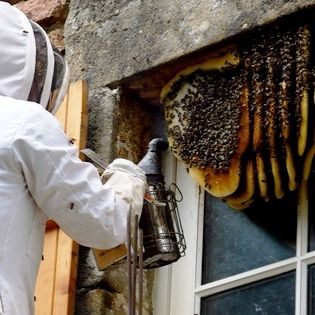From shady tree branches to quiet attic corners, wasps have a knack for building their homes in the least expected places. While often unnoticed at first, their presence quickly becomes problematic—especially when their nests are disturbed. In Melbourne, wasp activity tends to surge during the warmer months, with several species establishing nests close to homes and public spaces. Knowing how to identify, understand, and manage these buzzing invaders can prevent painful stings and unwanted infestations. Whether you’re a homeowner or a business operator, wasp nest removal in Melbourne has become a necessary service to ensure peace of mind during wasp season.
Melbourne’s Wasps: Who Are These Silent Builders?
Wasps in Melbourne come in various species, each with its own behaviours and nesting habits. The European wasp is one of the most notorious, often found scavenging in rubbish bins or hovering around sugary drinks during outdoor gatherings. They’re aggressive, especially when threatened, and their stings can cause severe allergic reactions.
On the other hand, native paper wasps are usually more passive but will defend their nests fiercely if provoked. Their nests look like little umbrellas and are often attached under eaves or pergolas.
Then there’s the mud-dauber wasp, a solitary species that constructs tube-like mud nests on brick walls or garage corners. While less aggressive, their presence still sparks concern for many property owners.
Understanding the type of wasp is the first step in deciding how best to deal with them. Misidentifying a harmless species can lead to unnecessary alarm or incorrect treatment methods.
Nesting Habits and Locations: Why Wasps Choose Your Home
Wasps are strategic in their nesting choices. They seek sheltered, undisturbed areas that provide warmth and easy access to food. This makes Melbourne’s backyards, roof cavities, sheds, and even letterboxes ideal nesting spots.
In suburbs like Armadale and Glen Waverley, residents frequently encounter wasp nests tucked in garden walls or tree hollows. Properties with compost bins or flowering gardens are particularly attractive to foraging wasps.
Wasps are seasonal builders. Nests usually begin in spring, grow rapidly in summer, and reach peak size by late summer. During this period, the risk of stings and aggressive behaviour increases dramatically, especially if the colony feels threatened.
Locating a nest early, before the colony matures, can significantly reduce the challenges of removal.
The Sting Factor: Why Wasps Attack Without Warning
Wasps sting as a defence mechanism. Unlike bees, they don’t lose their stinger and can sting multiple times, making them particularly dangerous when provoked. Loud noises, rapid movement, or even mowing the lawn near a nest can trigger an attack.
What makes wasps even more dangerous is their pheromone-based communication system. When one wasp stings, it releases chemicals that alert nearby wasps to join the attack. This can quickly escalate a single sting into a swarm response.
For individuals in Kensington or South Yarra, where outdoor dining and communal green spaces are common, wasp activity poses both a nuisance and a safety risk. Children and pets are particularly vulnerable due to their curious nature and tendency to unintentionally provoke nests.
Understanding these behaviours can help reduce unnecessary risks, especially during peak wasp activity seasons.
Modern Control Techniques: How Experts Manage Infestations
Gone are the days of simply spraying a nest and hoping for the best. Today’s wasp control techniques are targeted, humane, and environmentally considerate. Professionals begin with a thorough inspection of the property to locate nests and assess the species involved.
Depending on the nest’s location and type of wasp, treatment methods vary. Dust insecticides are effective for ground or wall cavity nests, while eco-friendly sprays are used for exposed nests in trees or under eaves. Removal is often done at night when wasps are less active and more contained.
In areas like Doncaster, where double-storey homes are common, wasp nests are often high up and difficult to access without specialist equipment. Professional wasp controllers use ladders, safety gear, and targeted tools to ensure safe and complete removal.
Importantly, these techniques also include preventive measures sealing access points, advising on landscaping changes, and implementing monitoring traps for future control.
DIY vs Professional Wasp Removal: Weighing the Risks
It might be tempting to take on a wasp nest alone, especially with the number of over-the-counter sprays available. However, DIY methods come with significant risk. Most DIY attempts disturb the nest without eliminating the entire colony, leading to defensive swarming.
Professional wasp control is not just about rMoreover, nests located inside walls, ceilings, or underground require knowledge of wasp movement patterns and access points—something best left to trained professionals. In tightly packed neighbourhoods like Wasp Removal Kensington, incorrect handling of a nest can also affect neighbouring properties.
Prevention Tips for a Wasp-Free Environment
Once the wasps are gone, prevention becomes the key focus. Keeping outdoor bins tightly sealed, regularly trimming trees and shrubs, and sealing cracks or gaps in walls can deter wasps from nesting near your home.
In gardens across Glen Waverley and Armadale, flowering plants are abundant and naturally attract foraging wasps. While removing these plants isn’t necessary, placing decoy wasp traps or planting deterrents like eucalyptus and citronella can help manage attraction levels.
For those who’ve had repeated issues, seasonal inspections especially in early spring can help detect queen activity or early nest formations before they become a bigger problem.
Wasps may be quiet in how they build, but the danger they pose is loud and clear. Whether you’ve spotted a nest under the eaves, near your garden shed, or buzzing around bins, swift action is essential. For safe, effective, and expert-led wasp nest removal in Melbourne, rely on a team that truly understands the local wasp behaviours and seasonal pattern and to services across Armadale, Kensington, Box Hill, Camberwell, Flemington,and Hampton Park residents throughout Melbourne have access to trusted solutions that get results without the risk.
Call Wasps Control Melbourne on 03 9021 3738 to book an inspection or removal today and enjoy a safer, sting-free environment.




